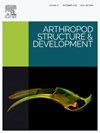3D is not just a tool - a study of the anal capsule in Craterostigmus tasmanianus Pocock (1902) (Chilopoda, Arthropoda)
IF 1.3
3区 农林科学
Q2 ENTOMOLOGY
引用次数: 0
Abstract
Craterostigmus tasmanianus Pocock, 1902, is a chilopod distinguished, among other features, by a unique structure known as the anal capsule. Morphological questions regarding the anal capsule pertain to the homology of its functional components when compared to other chilopods, as well as the morpho-functional mechanisms involved in its opening and closing. Additionally, there has been ongoing debate about the precise location of the anus on the anal capsule. Some studies have suggested that the anus is located at the posterior end of the capsule, while others have proposed a position in the middle of the ventral side of the capsule.
To address these questions, μCT and cLSM scans were conducted on the anal capsule of C. tasmanianus and the posterior segments of Scutigera coleoptrata (Linnaeus, 1758). The resulting data were processed using 3D visualization software. Different muscle groups were identified, and the cuticle was analyzed to determine the presence of resilin, a highly elastic component in arthropod cuticles.
Based on the findings, hypotheses were formulated regarding the morpho-functional mechanisms of movement and the homology of the anal capsule structures in C. tasmanianus and S. coleoptrata. The analysis also resolved the question of anus location, confirming that it is situated at the posterior end of the anal capsule.
三维技术不仅仅是一个工具——对1902年塔斯马那雄鼠肛门囊的研究(足足纲,节肢纲)
1902年的塔斯马尼亚角角鼠爪是一种足类动物,其独特的结构被称为肛门囊。关于肛囊的形态学问题涉及其功能成分与其他足类动物的同源性,以及其打开和关闭所涉及的形态功能机制。此外,关于肛门在肛门囊上的精确位置一直存在争议。一些研究认为肛门位于囊的后端,而另一些研究则认为肛门位于囊腹侧的中间位置。为了解决这些问题,我们用μCT和cLSM扫描了C. tasmanianus肛门囊和Scutigera coleoptrata后节(Linnaeus, 1758)。利用三维可视化软件对所得数据进行处理。鉴定了不同的肌肉群,并对角质层进行了分析,以确定弹性蛋白的存在,这是节肢动物角质层中的一种高弹性成分。在此基础上,对塔斯马纳纳河鼠和鞘翅河鼠的形态功能运动机制和肛囊结构的同源性提出了假设。分析还解决了肛门位置的问题,确认它位于肛门囊的后端。
本文章由计算机程序翻译,如有差异,请以英文原文为准。
求助全文
约1分钟内获得全文
求助全文
来源期刊
CiteScore
3.50
自引率
10.00%
发文量
54
审稿时长
60 days
期刊介绍:
Arthropod Structure & Development is a Journal of Arthropod Structural Biology, Development, and Functional Morphology; it considers manuscripts that deal with micro- and neuroanatomy, development, biomechanics, organogenesis in particular under comparative and evolutionary aspects but not merely taxonomic papers. The aim of the journal is to publish papers in the areas of functional and comparative anatomy and development, with an emphasis on the role of cellular organization in organ function. The journal will also publish papers on organogenisis, embryonic and postembryonic development, and organ or tissue regeneration and repair. Manuscripts dealing with comparative and evolutionary aspects of microanatomy and development are encouraged.

 求助内容:
求助内容: 应助结果提醒方式:
应助结果提醒方式:


